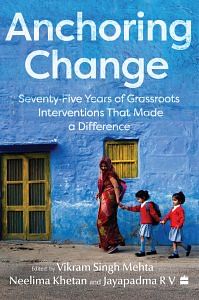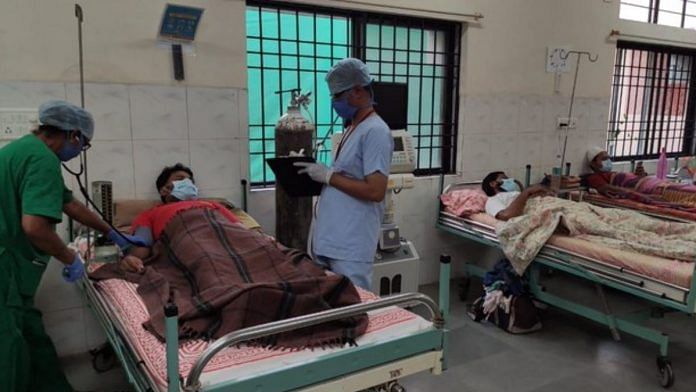Jamkhed, a town in central Maharashtra, is in a drought-prone area. It is surrounded by villages, with the nearest city of Ahmednagar more than an hour away. In the 1960s and 70s, people here were extremely poor, with high rates of malnutrition, infectious diseases, infant and maternal deaths and occupational injuries. They lacked basic healthcare services and access to appropriate curative care.
Social injustices such as the low status of women and caste-based prejudices contributed significantly to the chronic state of ill health of the village communities. The Comprehensive Rural Health Project (CRHP) in Jamkhed was set up by Drs. Raj and Mabelle Arole, who were doctors working with India’s rural poor and marginalized people. The Aroles had graduated from the Christian Medical College in Vellore and obtained their residency training in medicine and surgery and master of public health degrees as Fulbright Scholars at Johns Hopkins University in the USA. During their time there, they devised an innovative project based on comprehensive communitybased primary healthcare to effectively meet both the immediate as well as the long-term needs of poor and marginalized people, especially women. In 1970, the Aroles returned to India to establish the CRHP in Jamkhed.
CRHP is a comprehensive, community-based primary healthcare programme, focused on community empowerment. It became known as the ‘Jamkhed Model’, where community cooperation and participatory development were the jamkhed model 51 found to be most welcome and needed. Initially covering eight villages with a combined population of 10,000, CRHP rapidly expanded in its early years across village communities, spreading to cover over 300 villages.
Also read: Hidden agendas, corruption, tokenism—why social work and politics cannot survive together
The programme aimed to involve the community in addressing its health problems, to prevent and treat most of their health conditions using simple techniques and to tackle the root causes of health ailments—such as poverty, the social status of women and the caste system. Its focus was on the poorest people but involved the whole community. Since 1978, it has been recognized by the World Health Organization (WHO) and United Nations International Children’s Emergency Fund (UNICEF) as an effective way to deliver healthcare to marginalized populations while simultaneously addressing social injustices.
Its strategy was to develop a healthcare delivery programme suited to the needs and resources of the area. An essential element was community empowerment; from the outset, village communities were involved, and they participated in partnership with the project staff. The focus on equity, integration and empowerment of people were key to effecting change, leading to overall sustainable development and in turn to better health. The goal was to build the capacity of communities to participate actively and responsibly in primary healthcare activities in order to improve the physical, mental, emotional, psychological, social and economic health of the whole community. A multisectoral approach was seen as important, as health services needed to be integrated and appropriate technology used.
Also read: ‘Hot Mango Chutney Sauce’—a Pakistani girl’s struggle to live, bleed and die with dignity
Key Principles of the Jamkhed Model
Equity: This ensures that the needs of the poorest groups are addressed. They are brought into the fold of the larger community, ensuring their participation in identifying and addressing the root causes of their problems in order to resolve them. Even if not everyone receives equal healthcare, it is possible to ensure that everyone has access to it. Integration: CRHP’s approach to healthcare is multisectoral. The core belief is that health does not exist in isolation, but it is intrinsically related to education, the environment, sanitation, socioeconomic status and local 52 anchoring change traditions. Additionally, sometimes non-medical interventions are more effective and have greater impact on wellbeing. In fact, health and development are two sides of the same coin: people may be advised to wash their hands, but if they have neither the money for the soap nor enough water, how can they observe hygiene? These basic needs need to be addressed first.
Empowerment: This is one of the most important principles of the Jamkhed Model. Working at the grassroots with village health workers (VHWs) and community groups initiates a process of empowerment, of women in particular and communities in general. Once people have information and can make informed decisions, they have the power to consider constructive ways to transform their communities. They can also learn skills for themselves and to help others. This builds capacity in the community, enabling people to jointly assess and identify their problems, analyse the causes, decide what to work on and develop appropriate solutions. The focus is on helping the community to ‘heal’ itself and to gain control of their lives for the wellbeing of all.
Appropriate Technology: This applies to people (through on-the-job training), facilities (simple hospitals, community halls, home healthcare), supplies (basic and easily available), equipment (locally made and maintained), medicines (limited to an essential list), education (simple, through local media) and energy sources (renewable). Locally available resources such as people (labour, knowledge and ideas), money and materials are used as much as possible, including effective traditional methods and remedies. Equipment is technically appropriate and easily made, so it can be maintained and repaired locally. The village communities are involved through the use of simple and traditional media for health and education, and the VHWs use basic equipment and traditional, simple and effective remedies for prevention and treatment of illnesses. Examples of employing appropriate technology include utilizing VHWs, delegating duties to others less qualified but capable of performing tasks adequately and training persons with little formal education to do various tasks.
 This excerpt from ‘Anchoring Change: Seventy Five Years of Grassroots Interventions That Made a Difference’ has been published with permission from Harper Collins India
This excerpt from ‘Anchoring Change: Seventy Five Years of Grassroots Interventions That Made a Difference’ has been published with permission from Harper Collins India



